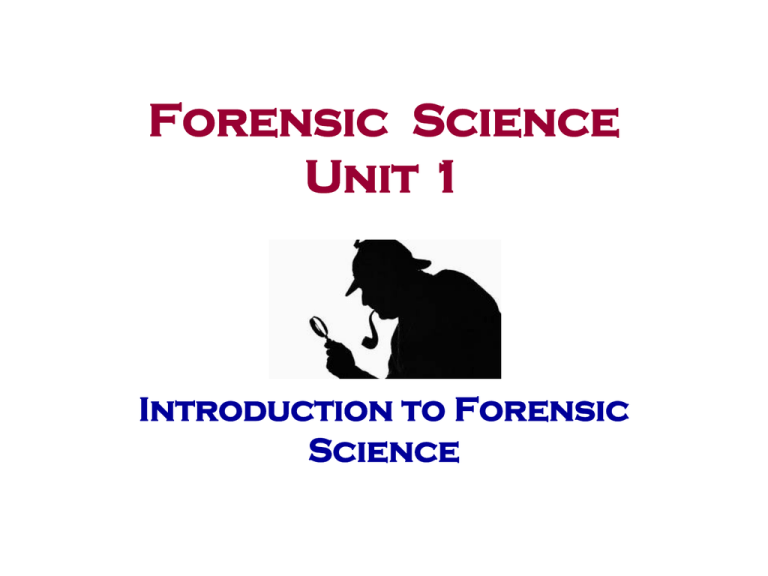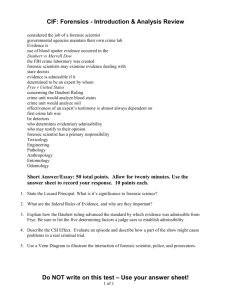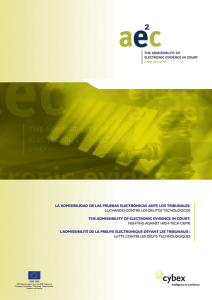Forensic Science Unit 1
advertisement

Forensic Science Unit 1 Introduction to Forensic Science I. Introduction • What is forensic science? - In it’s broadest definition it is the application of science to law. Forensic science – the application of science to those criminal and civil laws that are enforced by police agencies in a criminal justice system. History and Development of Forensic Science • One of the earliest records of applying forensics to solve criminal cases comes from third-century china. A manuscript titled yi yu ji (A collection of criminal cases) reports how a coroner solved a case in which a woman was suspected of murdering her husband and burning the body then claiming that he died in an accidental fire. Noticing that the husband’s corpse had no ashes in its mouth, the coroner performed an experiment to test the woman’s story. He burned two pigs – one alive and one dead – and then checked for ashes inside the mouth of each. He found ashes in the mouth of the pig that was alive before it was burned but none in the mouth of the pig that was dead beforehand. The coroner thus concluded that the husband, too, was dead before his body was burned. Confronted with this evidence, the woman admitted her guilt. Anthropometry • A system developed by French scientist Alphonse Bertillon in 1879. • Was a systematic procedure that involved taking a series of body measurements as a means of distinguishing one individual from another. Twentieth-Century Breakthroughs The pace of technological change advanced forensics rapidly. • 1901: Dr. Karl Landsteiner – Blood types • 1910: Albert Osborn -Questioned Documents (still in use today!) • Col Calvin Goddard – comparison microscope use Locard’s exchange Principle • Frenchman Edmond Locard believed that when a criminal came in contact with an object or person, a cross transfer of evidence occurred. II. Crime Laboratories History of Crime labs in the U.S. • The oldest forensic laboratory in the United States is that of the Los Angles Police Department - created in 1923 by august vollmer. • In 1932 the FBI organized a national laboratory that offered forensic services to all law enforcement agencies in the country. • There is no national system of forensic laboratories. Instead, many local law enforcement jurisdictions – city, county, and state- each operate their own independent crime labs. • Laboratory staff sizes vary and services may be diverse or specialized. 1. FBI – belongs to the department of justice (doj) 2. DEA – belongs to the department of justice (doj) Broad investigative powers Analysis of drugs and all related items 3. ATF – Belongs to the department of the Justice 4. U.S. Postal Inspection Services - part of USPS Alcoholic beverages, weapons, explosive devices, gun control & organized crime Criminal investigations related to the postal service State and Local Agencies Georgia Bureau of Investigation (gbi) – handles crime scenes for counties without their own criminalists. Cobb County Police Department (CCPD) Cobb County Sheriffs Department III. Real Forensic Science • Like TV shows, the real forensic scientist does work the crime scene and processes the evidence in the lab. They also testify in court about that evidence. • They DON’T investigate in other ways such as questioning suspects. Analyzing of Physical Evidence • Compared to confessions and eyewitness accounts, only physical evidence is free of inherent error or bias. • The scientific method is a process that uses strict guidelines to ensure careful and systematic collection, organization, and analysis of evidence. Admissibility of Evidence • The rejection of the scientific validity of the lie detector (polygraph) established a standard guideline for determining the judicial admissibility of scientific examinations. Frey v. United States • The courts ruled that in order to be admitted as evidence at trial, the questioned procedure, technique, or principles must be “generally accepted” by a meaningful segment of the relevant scientific community. • Usually requires collection of experts to testify or books/papers written on the subject. Federal Rules of Evidence • In this alternative to Frey a witness “qualified as an expert by knowledge, skill, experience, training, or education” may offer expert testimony if (1) there are sufficient facts or data. (2) it is the product of reliable principles and methods. (3) the witness has applied the principles and methods reliably to the facts of the case. Daubert v. Merrell Dow Pharmaceuticals, Inc • In 1993, the U.S. Supreme Court asserted that “general acceptance” is not an absolute prerequisite to the admissibility of scientific evidence. Guidelines for admissibility Suggested areas of inquiry: 1. Technique or Theory can be tested. 2. Technique or theory has been subject to peer review & publication. 3. Potential rate of error. 4. Existence & Maintenance of standards controlling the operation. 5. Widespread scientific acceptance. Providing Expert Testimony • Expert witness – An individual whom the court determines to possess a particular skill or knowledge in a trade or profession that is not expected of the average layperson and that will aid a court in determining the truth of a matter at trial.







